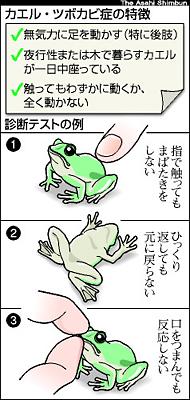 Asia's first confirmed case of chytridiomycosis, a fatal infectious disease that affects amphibians, has been discovered in the Tokyo area. The disease has resulted in dramatic population declines and extinctions in the Americas and Australia and is a primary cause of shrinking frog populations in many areas around the world.
Asia's first confirmed case of chytridiomycosis, a fatal infectious disease that affects amphibians, has been discovered in the Tokyo area. The disease has resulted in dramatic population declines and extinctions in the Americas and Australia and is a primary cause of shrinking frog populations in many areas around the world.
Although chytridiomycosis poses no danger to mammals (including humans), birds or reptiles, there is great danger to amphibians. The disease is caused by exposure to Batrachochytrium dendrobatidis, a parasitic chytrid fungus that kills more than 90% of amphibians that come into contact with it.
A consortium of 16 environmental groups, including World Wildlife Fund Japan, the Japanese Society of Zoo and Wildlife Medicine, and the Herpetological Society of Japan, plan to issue an emergency declaration calling for increased quarantine efforts and closer monitoring of the sale and distribution of amphibians.
The disease was discovered by a Tokyo-area resident who keeps South and Central American frogs as pets. In November and December last year, 14 of his 35 frogs (11 species) died suddenly. Laboratory analysis at Azabu University in Kanagawa prefecture revealed chytridiomycosis as the cause of death. The likely source of the infection was a frog purchased at a pet store at the end of October.
Azabu University researchers warn there is no way to control the disease if it spreads outdoors, and that it will trigger the widespread death of frogs in Japan.
The environmental groups are asking people to check their frogs for signs of the disease. Symptoms include lifelessness, red spots on the skin and other unusual skin conditions. People are encouraged to seek treatment for their pets if the disease is found, and are urged not to abandon their amphibians in the wild.
/// Text in illustration ///
Signs of chytridiomycosis
- Leg movement appears lethargic
- Nocturnal/tree-dwelling frogs sit still the entire day
- Frog does not move when touched
Checking for chytridiomycosis
(1) Frog does not blink when touched.
(2) Frog does not try to turn over when flipped on its back.
(3) Frog does not react when mouth is pinched shut.
[Source: Asahi]

alvinwriter
It's amazing how such a fungus plague had remained unaddressed for so long---long enough to kill countless frogs all over the world. Perhaps this should be taken as a wake up call to biologists and environmentalists in general. A big question is how did this fungus become so prolific?
http://www.thenewsroom.com/more/Science+and+Technology?type=T&start=3?c_id=ar
[]